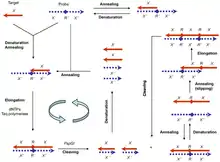Polymerase-endonuclease amplification reaction
Polymerase-endonuclease amplification reaction (PEAR) is a DNA amplification technology for the amplification of oligonucleotides.[1][2] A target oligonucleotide and a tandem repeated antisense probe are subjected to repeated cycles of denaturing, annealing, elongation and cleaving, in which thermostable DNA polymerase elongation and strand slipping generate duplex tandem repeats, and thermostable endonuclease (PspGI) cleavage releases monomeric duplex oligonucleotides.

Schematic description of PEAR.[1]
PEAR has the potential to be a useful tool for:
- Large-scale production of oligonucleotides.
- PEAR is a minimal DNA replication system, so it can be considered as a minimal life system. it is of therectical interests to study the origin and evolution of repetitive DNA.
- The repetitive DNA products can be transferred directly into cells or organisms to study the function of the repetitive DNA.
References
- Wang, Xiaolong; Deming Gou; Shuang-yong Xu (January 1, 2010). "Polymerase-Endonuclease Amplification Reaction (PEAR) for Large-Scale Enzymatic Production of Antisense Oligonucleotides". PLoS ONE. 5 (1): 7. doi:10.1371/journal.pone.0008430. PMC 2797076. PMID 20062528. Retrieved 22 August 2011.
- Li, Biao; Dong, Shihua; Wu, Jiajun; Zhang, Jianye; Chen, Gang; Dong, Quanjiang; Zhu, Xinhong; Wang, Xiaolong (2013-07-04). "Preparation of 5′-O-(1-Thiotriphosphate)-Modified Oligonucleotides Using Polymerase-Endonuclease Amplification Reaction (PEAR)". PLOS ONE. 8 (7): e67558. doi:10.1371/journal.pone.0067558. ISSN 1932-6203. PMC 3701678. PMID 23861771.
This article is issued from Wikipedia. The text is licensed under Creative Commons - Attribution - Sharealike. Additional terms may apply for the media files.